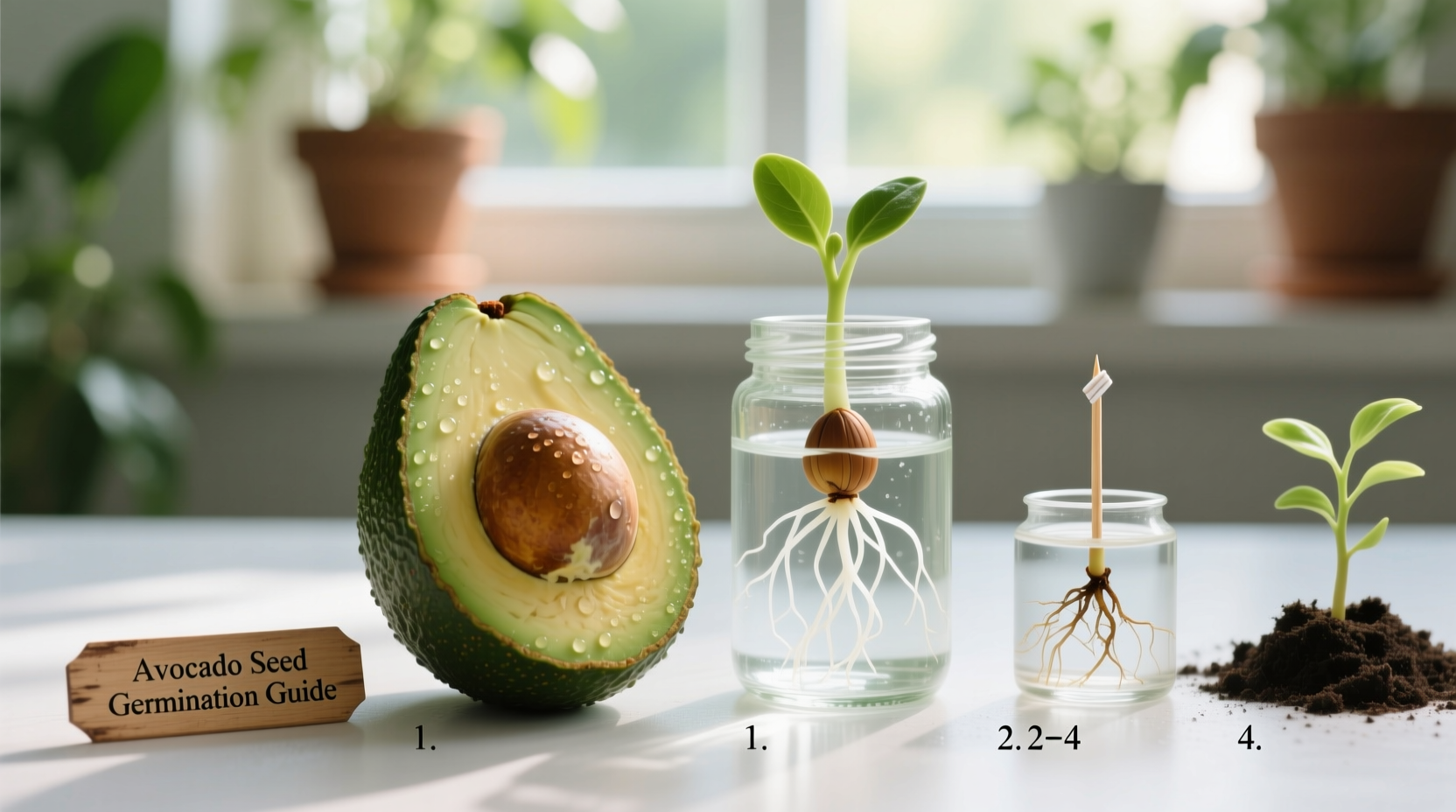Why Growing Avocado from Seed Is Worth Your Time
Transform your kitchen scrap into a lush houseplant with this beginner-friendly gardening project. Unlike commercial avocado trees grown for fruit production, seed-grown plants create beautiful ornamental specimens that purify indoor air and connect you to nature. The entire process from pit to plant takes just a few simple steps you can complete with household items.
Essential Supplies Checklist
Before starting, gather these basic materials:
- Fresh avocado seed (from ripe fruit)
- Toothpicks (3-4)
- Clear glass or jar
- Filtered water
- Potting soil (well-draining mix)
- Small pot with drainage holes

Step-by-Step Germination Process
Preparing Your Avocado Seed
Choose a mature avocado seed with intact brown skin. Gently wash away all fruit residue without removing the protective seed coat. Identify the top (pointed end) and bottom (flat end) - the root emerges from the bottom while the stem grows from the top. This orientation is critical for successful avocado pit germination methods.
Water Propagation Method (Most Reliable)
Insert three toothpicks horizontally into the seed's midsection. Suspend the seed over water with the bottom 1 inch submerged. Place in indirect sunlight at 65-75°F (18-24°C). Change water every 3-5 days to prevent bacterial growth. This avocado seed water propagation technique typically shows results within 2-8 weeks.
| Germination Method | Success Rate | Time to Sprout | Difficulty Level |
|---|---|---|---|
| Water Propagation | 85% | 3-6 weeks | Beginner |
| Direct Soil Planting | 60% | 4-8 weeks | Intermediate |
| Baggy Method | 75% | 2-4 weeks | Intermediate |
Transplanting to Soil
Once your seedling reaches 6-7 inches with multiple leaves, transplant to soil. Use a potting mix with perlite for drainage. Plant with the top half of the seed exposed to prevent rot. Water thoroughly but allow top inch of soil to dry between waterings. This transplanting avocado seedling to soil step requires careful handling of the delicate root system.
Troubleshooting Common Problems
Why Isn't My Avocado Seed Sprouting?
If your seed hasn't sprouted after 8 weeks, check these factors:
- Water temperature: Maintain 70-80°F (21-27°C) - cold water slows germination
- Water level: Bottom must stay submerged but top should remain dry
- Seed viability: Grocery store avocados may have been chilled, reducing sprouting success
According to University of California Agriculture and Natural Resources, "Avocado seeds from fruit stored below 40°F often fail to germinate due to chilling injury" (ucanr.edu).
Yellowing Leaves Solution
Yellow leaves typically indicate overwatering. Allow soil to dry completely before watering again. If problem persists, check for root rot by gently removing the plant. Trim any black, mushy roots and repot in fresh soil. Proper avocado plant care instructions include watering only when the top inch of soil feels dry.
Realistic Expectations for Home Growers
While growing avocado from seed is satisfying, understand these limitations:
- Fruit production: Homegrown plants rarely fruit indoors (may take 10-15 years)
- Plant size: Can reach 6-8 feet tall indoors without pruning
- Climate needs: Requires consistent warmth (no drafts) and bright indirect light
Texas A&M AgriLife Extension confirms that "avocado trees grown from seed exhibit significant genetic variation and seldom produce fruit identical to the parent tree" (aggie-horticulture.tamu.edu).
Advanced Tips for Healthy Growth
For optimal development of your avocado plant indoors, follow these professional techniques:
- Rotate the plant weekly for even growth
- Pinch off the top leaves when plant reaches desired height to encourage bushiness
- Fertilize monthly during growing season with balanced houseplant food
- Mist leaves regularly to increase humidity
Frequently Asked Questions
How long does it take for an avocado seed to sprout?
Most avocado seeds sprout within 2-8 weeks using the water propagation method. Factors affecting sprouting time include seed freshness, temperature (ideal range 70-80°F), and proper orientation with the pointed end up. Cold water or improper seed orientation can significantly delay germination.
Can you grow an avocado tree from a grocery store pit?
Yes, you can grow a plant from grocery store avocado pits, but success rates vary. Seeds from commercially shipped avocados may have been chilled during transport, reducing viability. For best results, use pits from locally grown or recently purchased ripe avocados. While the plant will grow, it likely won't produce fruit identical to the parent tree due to genetic variation.
Why are my avocado seedling leaves turning yellow?
Yellow leaves typically indicate overwatering. Allow the top inch of soil to dry completely between waterings. If the problem persists, check for root rot by gently removing the plant from its pot. Trim any black, mushy roots and repot in fresh, well-draining soil. Ensure your pot has adequate drainage holes and avoid letting the plant sit in standing water.
Do avocado plants need direct sunlight?
Avocado plants prefer bright, indirect light rather than direct afternoon sun, which can scorch leaves. An east-facing window providing morning sun is ideal. If growing under artificial light, use full-spectrum bulbs for 12-14 hours daily. Insufficient light causes leggy growth, while too much direct sun creates brown, crispy leaf edges.
When should I transplant my avocado seedling to a larger pot?
Transplant when roots fill the current pot (typically when they circle the container or emerge from drainage holes). This usually occurs when the plant reaches 12-18 inches tall. Choose a pot 2-3 inches larger in diameter with good drainage. The best time for transplanting is spring or early summer during active growth. Avoid oversized pots, which increase the risk of overwatering.











 浙公网安备
33010002000092号
浙公网安备
33010002000092号 浙B2-20120091-4
浙B2-20120091-4